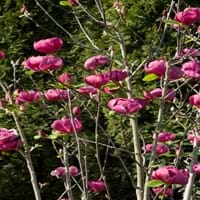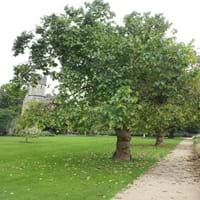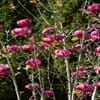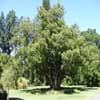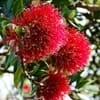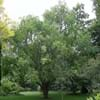Life Span
Perennial
Perennial
Origin
Hybrid origin
Southern Asia, Western Asia
Types
Not Available
White mulberry, Chinese mulberry, Red mulberry
Number of Varieties
Not Available
Habitat
Moist Soils, Well Drained
Dappled Shade, Sunny Edge, Woodland Garden Canopy
USDA Hardiness Zone
5-9
5-9
Sunset Zone
2b, 3a, 3b, 4, 5, 6, 7, 8, 9, 10, 12, 13, 14, 15, 16, 17, 18, 19, 20, 21, 22, 23, 24
H1, H2, 4, 5, 6, 7, 8, 9, 10, 11, 12, 13, 14, 15, 16, 17, 18, 19, 20, 21, 22, 23, 24
Habit
Narrow Upright/Fastigiate
Oval or Rounded
Minimum Height
Not Available
Minimum Width
Not Available
Flower Color
Burgundy, Violet
White, Gray Green
Flower Color Modifier
Bicolor
Bicolor
Leaf Color in Spring
Dark Green
Green
Leaf Color in Summer
Dark Green
Green
Leaf Color in Fall
Green
Yellow
Leaf Color in Winter
Not Available
Not Available
Leaf Shape
Oval
Heart-shaped
Plant Season
Spring, Summer, Fall, Winter
Summer, Fall
Sunlight
Full Sun, Partial Sun
Full Sun, Partial Sun
Type of Soil
Loam
Clay, Loam, Sand
The pH of Soil
Acidic, Neutral
Acidic, Neutral, Alkaline
Soil Drainage
Well drained
Average
Bloom Time
Early Spring, Spring
Late Spring
Tolerances
Not Available
Drought
Where to Plant?
Ground
Ground
How to Plant?
Rooted stem cutting, Seedlings
Seedlings, Stem Cutting
Plant Maintenance
Medium
Medium
Watering Requirements
Average Water Needs
Requires regular watering, Water daily during growing season, Water Deeply
In Summer
Lots of watering
Lots of watering
In Spring
Moderate
Moderate
In Winter
Average Water
Average Water
Soil pH
Acidic, Neutral
Acidic, Neutral, Alkaline
Soil Type
Loam
Clay, Loam, Sand
Soil Drainage Capacity
Well drained
Average
Sun Exposure
Full Sun, Partial Sun
Full Sun, Partial Sun
Pruning
Prune in late summer or fall, Prune in late winter, Remove damaged leaves, Remove dead branches, Remove dead leaves, Remove dead or diseased plant parts
Prune when plant is dormant, Remove damaged leaves, Remove dead branches, Remove dead leaves, Remove dead or diseased plant parts, Remove deadheads
Fertilizers
All-Purpose Liquid Fertilizer, fertilize in spring
Apply 10-10-10 amount
Pests and Diseases
Red blotch
Red blotch
Plant Tolerance
Not Available
Drought
Flower Petal Number
Single
Single
Foliage Texture
Medium
Coarse
Foliage Sheen
Matte
Matte
Attracts
Bees, Birds, Butterflies
Birds
Allergy
Not Available
Pollen
Aesthetic Uses
Showy Purposes
Not Used For Aesthetic Purpose
Beauty Benefits
Not Available
Anti-ageing, Good for skin and hair, Promotes Healthy Hair
Edible Uses
Insignificant
Yes
Environmental Uses
Air purification
Air purification, Food for animals, Food for birds, Shadow Tree, Shelter for wildlife, Wildlife, Windbreak
Medicinal Uses
Not Available
Anthelmintic, Astringent, Homeopathy, Hypoglycaemic, Laxative, Odontalgic, Purgative
Part of Plant Used
Bark, Buds, Flowers
Bark, Fruits, Stem, Wood
Other Uses
Used as Ornamental plant
Fibre, Used as a dye, Used for its medicinal properties, Wood is used for making furniture
Used As Indoor Plant
No
No
Used As Outdoor Plant
Yes
Yes
Garden Design
Container, Feature Plant, Foundation, Mixed Border
Edible, Feature Plant, Fruit / Fruit Tree, Shade Trees
Botanical Name
MAGNOLIA x soulangiana 'Jurmag1'
MORUS nigra
Common Name
Black Tulip Magnolia, Saucer Magnolia
Black Mulberry
In Hindi
Black Tulip Magnolia Tree
काले शहतूत के पेड़
In German
Black Tulip Magnolia Tree
Schwarze Maulbeerbaum
In French
Black Tulip Magnolia Arbre
Noir Mulberry Tree
In Spanish
Tulipán negro árbol de la magnolia
Negro árbol de mora
In Greek
Μαύρη Τουλίπα Magnolia Tree
Μαύρο Mulberry Tree
In Portuguese
Black Tree Magnolia Tulip
Árvore de Mulberry Preto
In Polish
Black Tulip Magnolia Drzewo
Czarny Mulberry Tree
In Latin
Magnolia lignum Niger Tulip
Niger arbori moro:
Phylum
Magnoliophyta
Magnoliophyta
Class
Magnoliopsida
Magnoliopsida
Order
Magnoliales
Urticales
Family
Magnoliaceae
Moraceae
Clade
Not Available
Angiosperms, Eudicots, Rosids
Tribe
Not Available
Moreae
Subfamily
Not Available
Not Available
Number of Species
Not Available
Importance of Black Tulip Magnolia and Black Mulberry
Want to have the most appropriate plant for your garden? You might want to know the importance of Black Tulip Magnolia and Black Mulberry. Basically, these two plants vary in many aspects. Compare Black Tulip Magnolia and Black Mulberry as they differ in many characteristics such as their life, care, benefits, facts, etc. Every gardener must at least have the slightest clue about the plants he wants to plant in his garden. Compare their benefits, which differ in many ways like facts and uses. The medicinal use of Black Tulip Magnolia is Not Available whereas of Black Mulberry is Anthelmintic, Astringent, Homeopathy, Hypoglycaemic, Laxative, Odontalgic and Purgative. Black Tulip Magnolia has beauty benefits as follows: Not Available while Black Mulberry has beauty benefits as follows: Not Available.
Compare Facts of Black Tulip Magnolia vs Black Mulberry
How to choose the best garden plant for your garden depending upon its facts? Here garden plant comparison will help you to solve this query. Compare the facts of Black Tulip Magnolia vs Black Mulberry and know which one to choose. As garden plants have benefits and other uses, allergy is also a major drawback of plants for some people. Allergic reactions of Black Tulip Magnolia are Not Available whereas of Black Mulberry have Pollen respectively. Having a fruit bearing plant in your garden can be a plus point of your garden. Black Tulip Magnolia has no showy fruits and Black Mulberry has showy fruits. Also Black Tulip Magnolia is not flowering and Black Mulberry is not flowering . You can compare Black Tulip Magnolia and Black Mulberry facts and facts of other plants too.
